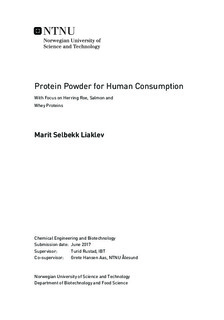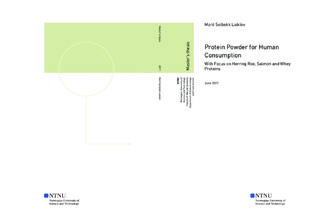| dc.description.abstract | The fish industry in Norway produced 885 000 tonnes of rest raw material in 2014. Today, most of the rest raw material from fish, such as herring (Clupea harengus) and Atlantic salmon (Salmo salar), is used in silage or fishmeal and -oil production for animal and fish feed. With a growing world population, it is important that the fish material is used as sustainably as possible. Transforming rest raw material from the fish industry into products for human consumption will increase the profitability of the industry. Protein powders made from herring and salmon can be used as functional ingredients in food or as a nutritional supplement.
The aim of this study was to compare the nutritional, functional, bioactive and sensory properties of protein powders from herring roe, salmon and whey. The chemical composition varied between the different raw materials, and the protein content ranged from 64.0 to 81.5 %. The herring protein powder (HPP) and whey protein powder (WPP) had the highest nutritional values due to a high con¬tent of proteins and essential amino acids, which exceeded the requirements set by FAO/WHO for an adult human. A pepsin/HCl solution was used to simulate the digestion of proteins in the stomach. The digestibility of the HPP and WPP were above
90 %, while the digestibility of salmon meal was approximately 72 %.
The molecular weights of the soluble proteins in the WPP and salmon meal were investigated with gel filtration. The WPP consisted mainly of peptide fractions with molecular weights of 4700 and 13 000 Da, while the salmon meal consisted of peptide fractions below 900 Da. This correlated well with the higher amount of free amino acids (FAA) measured for salmon meal dissolved in distilled water and citric acid-phosphate buffer, compared to the whey protein powder dissolved in the same solvents.
From earlier studies, the solubility of the herring protein powder was reported to be below
2 % in distilled water. Enzymatic hydrolysis with trypsin was performed and the effect on different characteristics and properties were investigated. The minor change in molecular weight distribution, low amount of FAA and acid soluble peptides, together with low a solubility (less than 7 %), indicate that the herring protein powder hydrolysate mainly consisted of insoluble intact proteins similar to the native HPP. This makes it difficult to use the powder in liquid products, such as sports drinks or drinking yoghurts.
The solubility of the salmon meal and WPP were also investigated, in addition to other functional properties such as emulsion capacity, emulsion stability, water holding capacity (WHC) and swelling capacity. The solubility was determined both as a function of pH and temperature. At a pH between pH 3 and 7, the solubility of the WPP and salmon meal ranged from 65.7 to 95.9 % and 14.2 to 18.1 %, respectively. The effect from increasing the temperature on the solubility of HPP and salmon meal was minimal. Both the emulsion capacity and stability were higher for the WPP compared to the salmon meal. Although the salmon meal was able to form an emulsion, it was not able to make it stabile, and this would make it difficult to use the salmon meal as an emulsifier in multiple phase foods. WHC was the functional property where salmon meal showed significantly better properties than WPP. The WHC of minced cod filets increased with addition of salmon meal, while it decreased with addition of WPP. A positive correlation was observed between a high water holding capacity and a high swelling capacity.
The antioxidant properties of whey protein powder was investigated with the DPPH scavenging method. The scavenging of the DPPH radicals increased with increasing WPP concentration. The DPPH method was not suitable for measuring the antioxidant properties of salmon meal and no results were obtained for the bioactive properties of this powder.
Bread rolls were made from mixtures of wheat flour, wholemeal and 0, 5, 10, 15 and 20 % of WPP, HPP or salmon meal. The bread rolls mixed with WPP received the best acceptance. The low solubility of the HPP resulted in a grainy mouthfeel at high protein concentrations. A fishy taste and odour, probably due to the high fat content (17.3 %) were the major problems with the salmon meal bread rolls. Protein addition above 10 % is probably necessary in order to increase the protein intake from bread rolls significantly.
Among the three protein powders investigated in this study, WPP has most likely the best potential as a food additive due to the high nutritional value and sensory acceptance. If the sensory properties of HPP could be improved by modifications of the proteins or taste masking, this powder could also be used in enrichment products. This would be desirable due to a high nutritional quality of the herring roe proteins. | |

